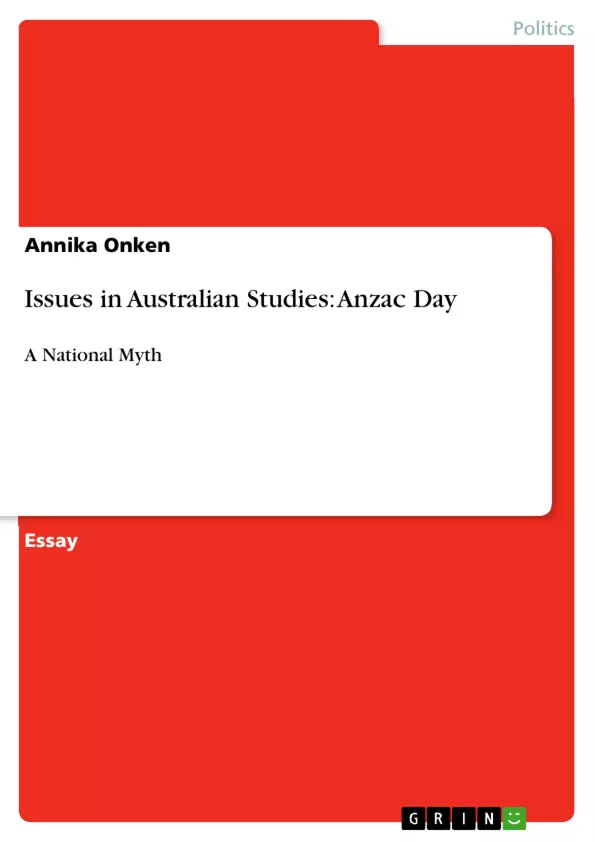Assumed that Anzac Day in its function as a national day is an invention (Seal 4), the question arises what understandings of the day are imposed on the recipients and how. A central point in this discussion is the idea that Anzac Day as a national myth builds a connection between the public life and the public history in the form of national sentiments as addressed by Davison (2003), Seal (2004), McKenna & Ward (2007), and White (2003). In comparing media material about Anzac Day from 1968 and 2009 I will look at how the establishment of this connection is aimed at in a militaristic framework and how understandings of it differ. Furthermore, I will investigate how far notions beyond this militaristic context are incorporated. How is the commemoration of Anzac Day understood in relation to a rising multiplicity of Anzac understandings?
Inhaltsverzeichnis (Table of Contents)
- Introduction
- 1968: Anzac Day in a Context of Humanity and International Orientation
- 1968: Anzac Day as a National Myth in the Light of the ‘Identity Struggle’
- 2009: Anzac Day as a Multifaceted Commemoration
- Anzac Day in 2009: A Shift from a War Context to a Broader Understanding
- Conclusion
Zielsetzung und Themenschwerpunkte (Objectives and Key Themes)
This essay analyzes the evolution of Anzac Day commemoration in Australia, examining how the national myth adapts to societal shifts and contemporary understandings. The primary goal is to compare media portrayals of Anzac Day in 1968 and 2009 to reveal how the connection between private life and public history through national sentiment is established and interpreted. The essay will also explore the extent to which notions beyond a militaristic context are incorporated into Anzac Day commemorations, highlighting the growing multiplicity of Anzac understandings.
- The evolution of Anzac Day commemoration in Australia
- The interplay between private life and public history in the context of national sentiment
- The militaristic framework of Anzac Day and its challenges
- The growing diversity of Anzac understandings
- The role of media in shaping perceptions of Anzac Day
Zusammenfassung der Kapitel (Chapter Summaries)
The essay begins by exploring media portrayals of Anzac Day in 1968, highlighting a sober approach that focuses on the event's historical context and the nation's evolution since World War I. While acknowledging the day's roots in remembering the fighting men, the focus shifts to commemorating Australia's progress towards a "new nationhood." However, the essay also notes a sense of instability and a fading Anzac spirit, reflected in the portrayal of veterans and the conflicting perspectives on the day's meaning.
The essay then contrasts the 1968 perspective with a more emotive portrayal of Anzac Day in the Sydney Morning Herald. This perspective emphasizes the role of veterans as role models, glorifying their sacrifice as a fundamental aspect of national identity. The sacred and secular are fused, with the Anzac spirit seen as embodied by the men who served in war. The essay also explores the attempt to establish a personal and sentimental connection between Anzac Day and the lives of women and children.
The essay then delves into the 2009 media portrayals, noting a continuation of the militaristic context while also acknowledging the emergence of a range of extended understandings of the Anzac spirit. This section highlights the ongoing celebration of military service as a core element of Australian identity, but also acknowledges the expanding scope of Anzac Day commemorations to encompass themes of mateship, social responsibility, and international goodwill.
Schlüsselwörter (Keywords)
Key concepts explored in this essay include Anzac Day commemoration, national myth, national sentiment, militaristic framework, societal shifts, media portrayals, Anzac spirit, mateship, and international orientation.
- Citar trabajo
- Annika Onken (Autor), 2009, Issues in Australian Studies: Anzac Day, Múnich, GRIN Verlag, https://www.grin.com/document/137781



